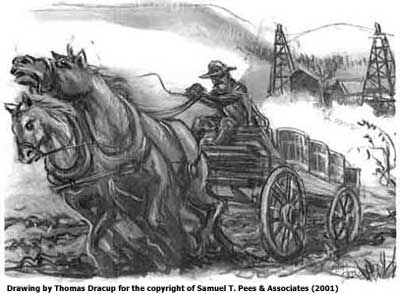 |
||||||
The Teamsters, A Good Word
When the earliest oil strikes (up to the fall of 1865) were made in the Pennsylvania oil region, the teamsters came by the thousands and went right to work hauling the oil in barrels to various destinations. The teamsters were a very essential link in the industrial chain in those early days. This herculean effort to get the wagon loads from place to place under the worst of conditions must have forged the very psyche of the wagoners and was passed down through the years. Surely no greater and daunting task loomed in the oil regions or elsewhere in those times.
Hauling oil in quantity by wagons required considerable facilities. The teamsters had to build barns, obtain feed for the horses, buy herds of fresh horses, hire blacksmiths, and have a ready supply of wagons, and sundry equipment. There was a network of suppliers that kept the teamsters going. The region also had to have accommodations for the thousands of teamsters (and thousands of other oilmen) so bunkhouses and hotels were quickly built. A good measure of the general business and prosperity of the early oil region was due to the presence of the free-spending teamsters. These men played a major role in the early days of the transportation of oil. Without them, the industry would have been in stalemate for years. The age of the teamsters was probably the most colorful, profane and laborious in the oil region. They were not only the carriers of oil, but each man was a business owner, his wagon seat being his office as well.
Although 300 to 400 teamsters would abandon the oil region with the opening up of each new major pipeline, many stayed. Equipment had to be hauled from the railroad stations to the oilfields and to the oil towns that were being built with each new field discovery. Instead of ripping up and scattering pipe as in the riot days, the teamster was now hauling pipe to the pipelines' right-of-ways then being built. The teamsters in the first half of the 1860's had learned how to lobby the Legislature, but the practically unknown art of a labor strike against the pipelines escaped them, so violent impedance seemed to be their only means. But they were soon to know that the economics of the pipeline would prevail regardless of their attempts to stop the flow of oil by force. Some left the region, some adapted. Eventually the teamster drove truck instead of a team of horses. His services remained essential to the industry long after pipelines came into use and will continue to do so.
 |
A teamster leaves Oil Creek Valley with a full load, 1864. |
The teamsters in the oil region were a wild bunch, but they did Herculean work in getting the barrels of crude oil out of the fields and to the railroads, river and canal. They delivered as far as Erie, a distance of 70 or more miles, but most hauls were made under 20 miles. They were profane, free spenders, heavy drinkers, brawlers and worse. However, a kind way of saying all that is simply to describe them as colorful noise-makers. It is said that some of their wagon lines were over a hundred wagons long. In the spring the muddy flats and "roads" were churned to grasping muck by the wheels and the hoofs of the teams. In winter, the ice-caked horses died after only a haul or two, due to the lash and mishaps on the arduous journey.
| © 2004, Samuel T. Pees all rights reserved |
|